Year: 2016 | Publisher: Bit Vision | Developer: Bit Vision| Original format: MSX | Version played: MSX
Since getting into the MSX in the late Nineties, I’ve always wanted to squeeze a little more out of the ancient Japanese computer to see what it can do. In the mid 2000s I upgraded to an MSX2 and shortly after starting this blog I got myself a 2+. All that remains is an MSX Turbo R, the final revision of the hardware, released only in Japan in 1990. I’m not sure if I’ll ever get one of these. Only two models were ever made, they’re now very expensive and support a tiny catalogue of games.

However, there is another way to supercharge an MSX and that’s with after-market V9990 cartridges. The Yamaha V9990 is a video processor chip dating back to 1992 and based on the chip originally intended for inclusion in the abandoned MSX3 system. Over the years, a few manufacturers have released such cartridges. Plugging them in to an MSX computer’s cartridge slot makes the system more powerful than any officially released hardware and allows developers to create much more visually impressive software.
I’m not technical enough to describe in detail how exactly what a V9990 cartridge does but I do know it allows for higher resolutions, more colours, more sprites and smoother scrolling. To my eyes, its games look more like something you would have found on the Amiga or Mega Drive. In fact, two of the V9990’s most popular games, Life On Earth and Metal Dragon, both have Mega Drive ports.
Since the V9990 MSX carts are an after-market invention, made long after the MSX’s commercial lifespan, its tiny handful of games are all indie/homebrew releases. Nevertheless, as a big fan of the MSX and curious tinkerer, I had to have one. You have to wait a long time for one of these carts to be made, since they tend to be produced in limited batches by enthusiastic hobbyists. But at the start of this year, I was able to snag a V9990 Power Graph Light from Brazil’s Technobytes.
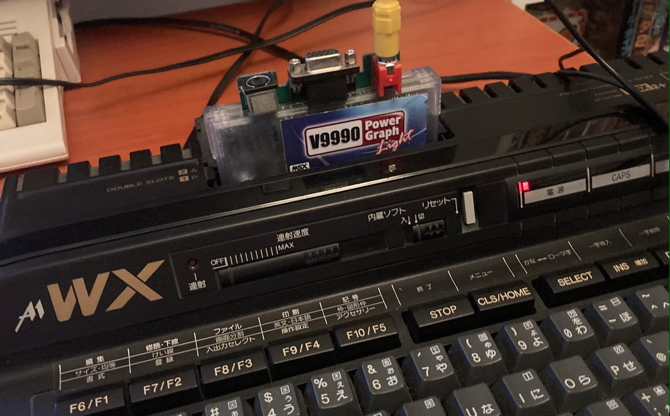
The first thing you’ll notice about the Power Graph Light is the three video-out ports – composite, s-video and VGA – protruding from the top of the cartridge. The MSX itself can’t output the V9990’s graphics through its regular video ports, so you’ll need to run a cable directly from the cart to your monitor or TV of choice, a bit like the way the Mega Drive’ 32X add-on also has its own video out. The even more curious thing is that it’s possible to still run a standard video single from the MSX computer to another monitor at the same time, and that’s how I discovered something truly special about one of the V9990’s best games, Codename: Intruder.
Under different circumstances it would be easy to overlook this unusual bonus feature. You’d plug the Codename: Intruder cart into one of the MSX’s cartridge slots and the Power Graph Light into another, outputting to a TV and you’d be off to the races. But in my case, I didn’t have the game on cartridge. It had sold out long before I was ready to buy one. Instead, I opted for a free digital version from the distributor’s website and installed it on a multi cart, which required me to display the regular MSX on a second screen.
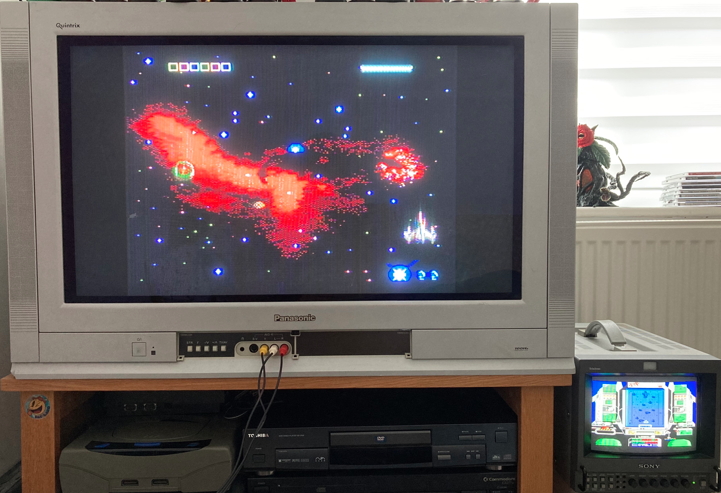
When I loaded up the game and absent-mindedly kept the second screen running, at first it displayed a message saying to make sure I switched to the V9990 output, but as I kept it running, I was soon surprised to see a title screen displayed that was entirely different to the one on the main TV screen. Incredibly, my MSX had become a dual screen system!
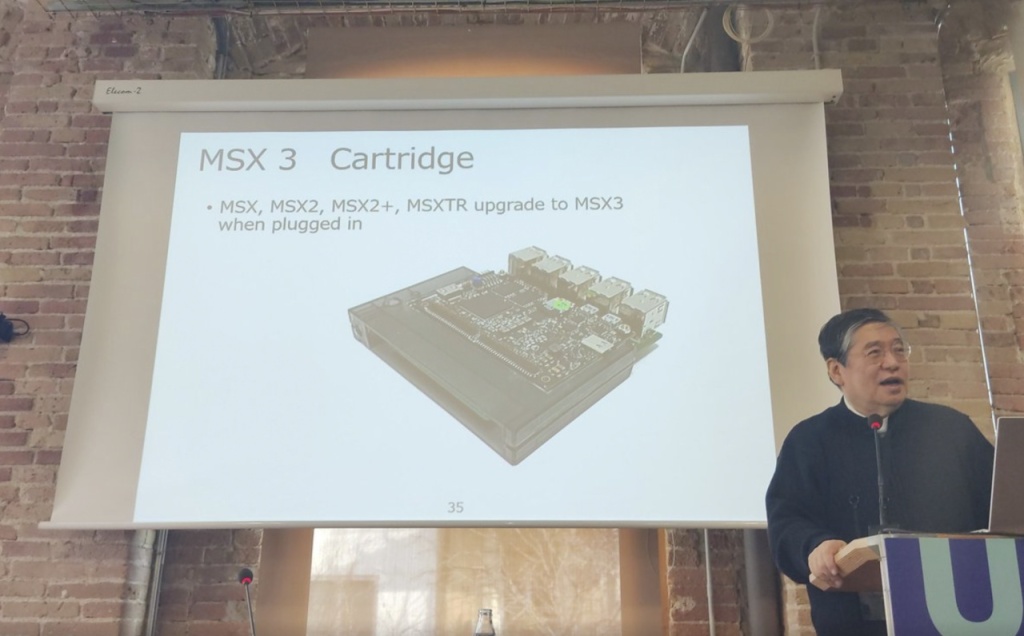
Intermission… Although the V9990 is a fan-made attempt to revive the MSX3 standard that was abandoned in the early 90s, three decades on, MSX creator Kazuhiko Nishi has unexpectedly announced a new, official MSX3. The system specs will be way more advanced than what was intended in the 90s but the hardware function is surprisingly similar to the V9990 cartridges. Nishi revealed earlier this year that any model of MSX, even the humble MSX1, will be upgradeable to MSX3 by inserting a cartridge with all of the new tech built in.
Even after spending a few weeks with this game, I’m still impressed by what it does. On the V9990 screen you have a vertically scrolling shoot-‘em-up, more visually striking than anything else on MSX, while on the second screen a map is displayed in the more basic 8-bit style the system is known for. Sure, you’re not really playing a game on two screens in the way you might on Nintendo DS but to see this trick pulled off by a computer whose roots extend back to 1983 is something pretty special.
Once I got my set-up exactly how I wanted it, I ran the main game screen through a very large CRT television, and had the second output to a small PVM right next to it. I like to think this approach simulates the feeling of piloting a fighter ship through space, the main screen effectively acting as my cockpit view and the tiny second screen representing a tactical display that might have sat just to the side of the ship’s controls or down between my legs, always there to glance at in case it’s needed.

The on-screen graphics of the second screen really lend weight to this sense of role-play with several information screens, levers and buttons displayed. The map itself is the main attraction and the closest thing the screen has to a practical application. It shows your ship’s progress through the stage in real-time and indicates when you’re getting close to the boss. But it’s the little details that make the screen so fun. An overhead, green screen schematic of your ship, a “PSG On” display in reference to the MSX’s standard sound chip and an ignition key with a dangling keychain, modelled on the developer’s logo. The more you play, the more hidden details you might see, including a secret cheat code that displays once you’ve finished the game.
Clever gimmicks aside, I’m pleased to say Codename: Intruder is also a pretty good shoot-‘em-up in its own right. The extra power of the V9990 is put to good use, with plenty of colours, detailed backgrounds and tons of sprites. The game design is pretty traditional. No bullet hell, just standard move and shoot gameplay and a standard temporary power-up system.

There are no continues either, so you really have to put those skills to good use. In fact, if I have one criticism of Codename: Intruder, it’s that it’s what I like to call… Bastard hard. The problem is that because the V9990 allows so many sprites on-screen at once, the developer really goes for it and, in places, there are so many enemies and bullets flying in all directions, that it becomes tricky to navigate them. Thankfully you get one smart bomb per life, the controls are super tight and the game never seems to slow down or skip frames, no matter how much the action hots up. So it all feels like you could get to the end with enough practice.
I don’t have much more to say about the game itself. If you’ve played any vertical shooter from the early years of the arcades then you’ll know what to expect here. It doesn’t really offer anything new, but it does what you’d expect with a level of competence that does go beyond most homebrew games. It’s easily as good as many Amiga shmups, and when I think about the best vertically scrolling shooters on MSX, like Aleste or Laydock, I can honestly say I’d prefer to play Codename: Intruder on most days. Especially since the extra graphical oomph, and compatibility with an SCC sound cartridge make the audio-visual experience more impressive. I particularly enjoyed pumping the excellent music out from two monitors at once!
Playing something like Codename: Intruder is a perfect reminder of just how valuable the retro gaming community is. This isn’t just a game made for a system forty years after its initial release, it’s also only made possible when combined with new hardware created by passionate supporters of the system. In some ways, it’s a natural evolution of the original vision behind the MSX itself; a computer designed to be endlessly expandable and supported by multiple manufacturers at once. In others, it’s a testament to what can be done when a community loves a system so much they just won’t let it die.
FIVE LITTLE THINGS I LIKE ABOUT CODENAME: INTRUDER
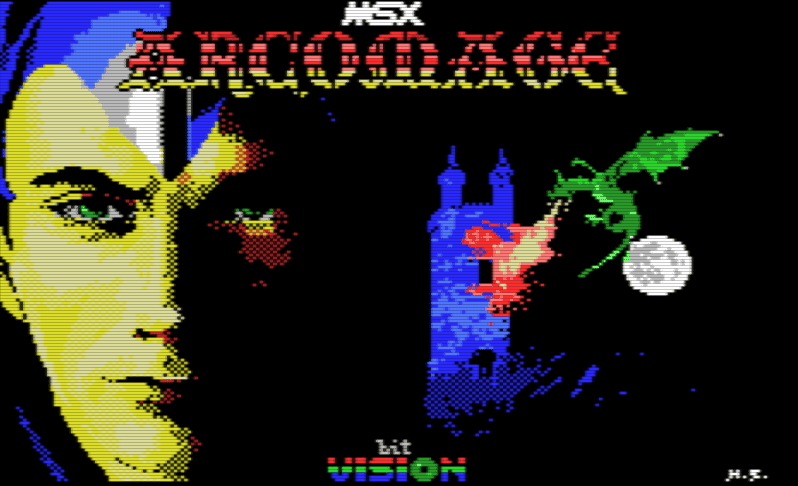
1. Back in the day, Konami used to make use of the MSX’s twin cartridge slots to enable cheats and secrets by plugging in two different games at once. Codename: Intruder pays homage to this by activating an invincibility mode if you have Bit Vision’s previous title, Arcomage, inserted at the same time. Of course, since Codename: Intruder requires a V9990 cart to run, you’ll need either an MSX with more than two slots (which is pretty rare) or a slot expander. So this particular combination of software and hardware has probably only been seen by the most hardcore MSX users.
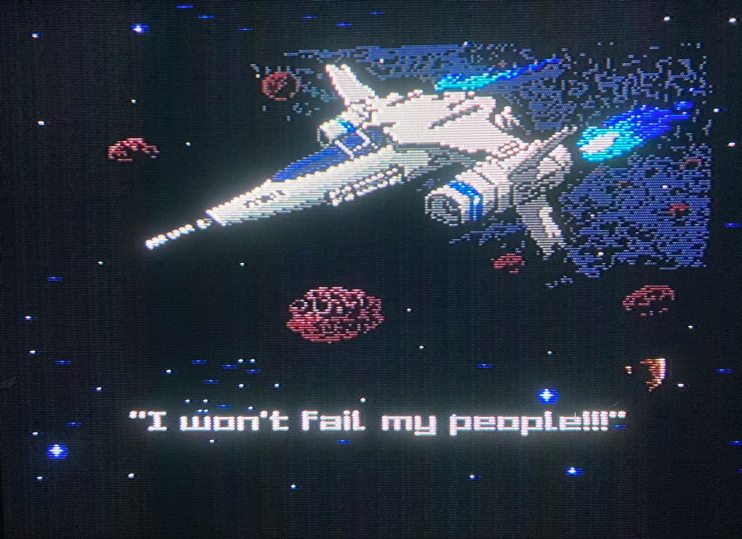
2. Codename: Intruder includes a nice little series of intro screens to set the scene; an appreciated touch for a homebrew game made by just one person. I particularly like this screen with its detailed view of the ship.
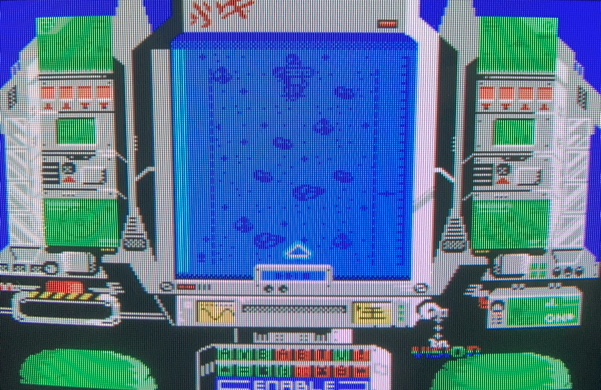
3. One of my favourite things on the second screen are the two green mounds at the bottom, which I’m pretty sure are meant to be the pilot’s knees, viewed in first-person. They really help sell the illusion of viewing controls and displays in the cockpit.
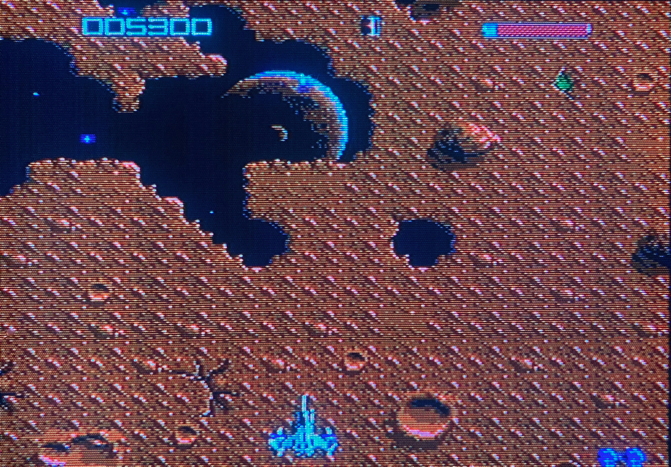
4. The opening stage features two background layers that scroll independently, so you get to glimpse moons, stars and planetoids through the holes in the rocky surface below as you fly by.

5. Free a power-up from its housing and instead of disappearing off the screen as you scroll by, it will bounce around the screen for a while like a classic DVD player screensaver. This allows you to be tactical, especially with the health power-up, as you can delay picking it up until you really need it.
Finally, how about some music from Codename: Intruder…
Follow…
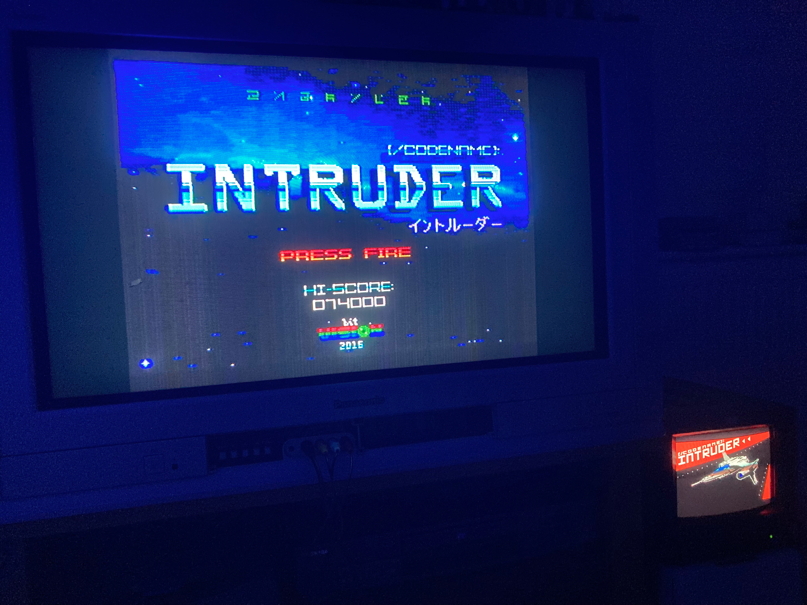
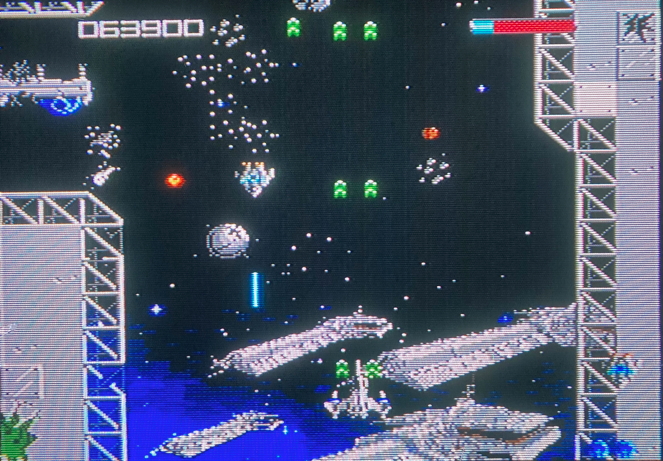
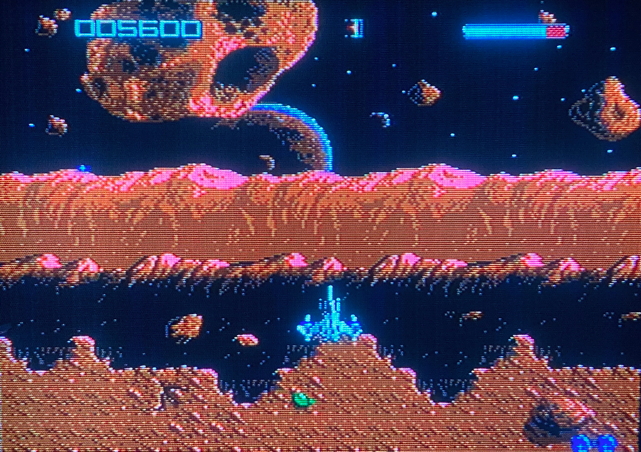

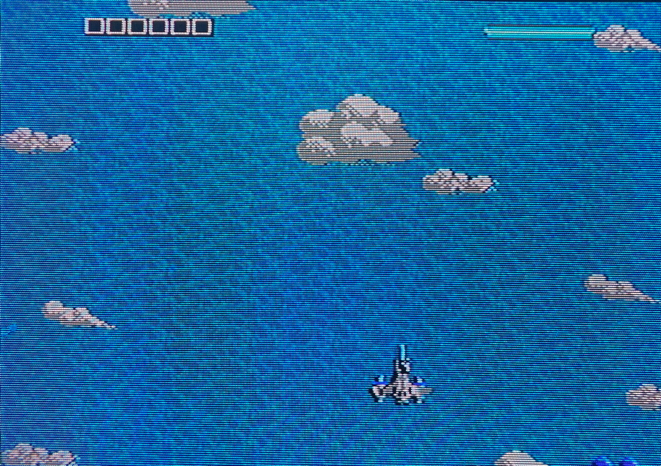
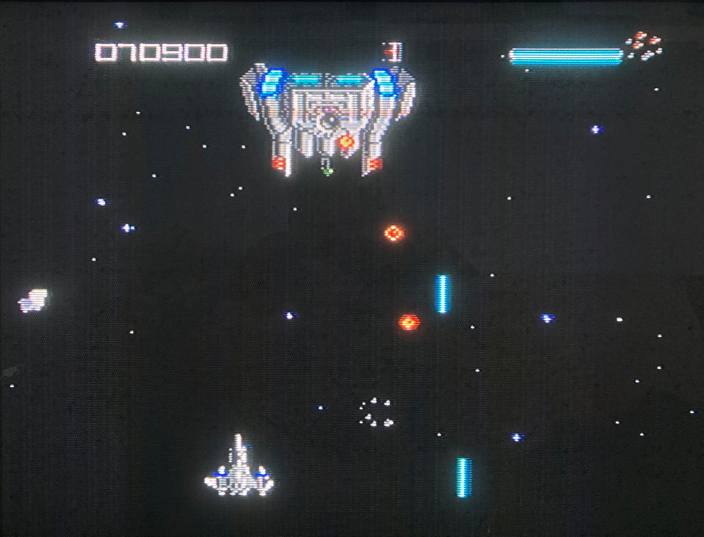
Great deep review!
Just one comment about the second screen two mounds: the green color is important… if you watch any of the two game endings it matches with the intruder race.
LikeLike